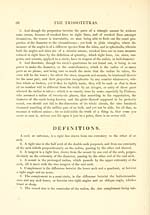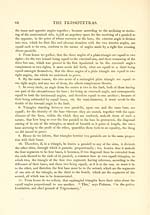Maitland Club > Works of Sir Thomas Urquhart
(109) Page 67
Download files
Complete book:
Individual page:
Thumbnail gallery: Grid view | List view

THE TRISSOTETRAS. 67
tracted from it ; and though great use may be made of the versed sines, for finding out of
the angles by the sides, and sides by the angles, yet in logarithmicall calculations they
are altogether uselesse, and therefore in my Trissotetras there is no mention made of
them.
8. In amblygonosphericalls, which admit both of an extrinseeall and intrinsecall
demission of the perpendicular, nineteen severall parts are to be considered ; viz. the
perpendicular, the subtendentall, the subtendentine, two cosubtendents, the basall, the
basidion, the chief segment of the base, two cobases, the double verticall, the verticall, the
verticaline, two coverticalls, the nest cathetopposite, the prime cathetopposite, and
the two cocathetopposites ; fourteen wherof, to wit, the subtendentall, the subten-
dentine, the cosubtendents, the basall, the basidion, the cobases, the verticall, the
verticaline, the coverticalls, and cocathetopposites, are called the first, either subten-
dent, base, topangle, or cocathetopposite, whither in the great triangle or the little,
or in the correctangle, if they be ingredients of that rectangular whereof most parts are
known, which parts are alwayes a subtendent and a cathetopposite ; but if they be in
the other triangle, they are called the second subtendents, bases, and so forth.
9. The external! double verticall is included by the perpendicular and subtendentall,
and divided by the subtendentine ; the internall is included by cosubtendents, and di-
vided by the perpendicular.
APODICTICKS.
The angles made by a right line falling on another right line, are equall to two right
angles ; because every angle being measured by an arch, or part of a circumference,
and a right angle by ninety degrees, if upon the middle of the ground line, as center,
be described a semi-circle, it will be the measure of the angles, comprehended betwixt
the falling and sustaining lines.
2. Hence it is that the four opposite angles made by one line crossing another, are
always each to its own opposite equall ; for if upon the point of intersection, as center,
be described a circle, every two of those angles will fill up the semi-circle ; therefore the
first and second will be equall to the second and third, and consequently the second,
which is the common angle to both these couples, being removed, the first will remain
equall to the third, and by the same reason, the second to the fourth, which was to
be demonstrated.
3. If a right line falling upon two other right lines make the alternat angles equall,
these lines must needs be paralell ; for if they did meet, the alternat angles would not
be equall, because in all plain triangles, the outward angle is greater then any of the
remote inward angles, which is proved by the first.
4. If one of the sides of a triangle be produced, the outward angle is equall to both
tracted from it ; and though great use may be made of the versed sines, for finding out of
the angles by the sides, and sides by the angles, yet in logarithmicall calculations they
are altogether uselesse, and therefore in my Trissotetras there is no mention made of
them.
8. In amblygonosphericalls, which admit both of an extrinseeall and intrinsecall
demission of the perpendicular, nineteen severall parts are to be considered ; viz. the
perpendicular, the subtendentall, the subtendentine, two cosubtendents, the basall, the
basidion, the chief segment of the base, two cobases, the double verticall, the verticall, the
verticaline, two coverticalls, the nest cathetopposite, the prime cathetopposite, and
the two cocathetopposites ; fourteen wherof, to wit, the subtendentall, the subten-
dentine, the cosubtendents, the basall, the basidion, the cobases, the verticall, the
verticaline, the coverticalls, and cocathetopposites, are called the first, either subten-
dent, base, topangle, or cocathetopposite, whither in the great triangle or the little,
or in the correctangle, if they be ingredients of that rectangular whereof most parts are
known, which parts are alwayes a subtendent and a cathetopposite ; but if they be in
the other triangle, they are called the second subtendents, bases, and so forth.
9. The external! double verticall is included by the perpendicular and subtendentall,
and divided by the subtendentine ; the internall is included by cosubtendents, and di-
vided by the perpendicular.
APODICTICKS.
The angles made by a right line falling on another right line, are equall to two right
angles ; because every angle being measured by an arch, or part of a circumference,
and a right angle by ninety degrees, if upon the middle of the ground line, as center,
be described a semi-circle, it will be the measure of the angles, comprehended betwixt
the falling and sustaining lines.
2. Hence it is that the four opposite angles made by one line crossing another, are
always each to its own opposite equall ; for if upon the point of intersection, as center,
be described a circle, every two of those angles will fill up the semi-circle ; therefore the
first and second will be equall to the second and third, and consequently the second,
which is the common angle to both these couples, being removed, the first will remain
equall to the third, and by the same reason, the second to the fourth, which was to
be demonstrated.
3. If a right line falling upon two other right lines make the alternat angles equall,
these lines must needs be paralell ; for if they did meet, the alternat angles would not
be equall, because in all plain triangles, the outward angle is greater then any of the
remote inward angles, which is proved by the first.
4. If one of the sides of a triangle be produced, the outward angle is equall to both
Set display mode to: Large image | Transcription
Images and transcriptions on this page, including medium image downloads, may be used under the Creative Commons Attribution 4.0 International Licence unless otherwise stated. ![]()
| Publications by Scottish clubs > Maitland Club > Works of Sir Thomas Urquhart > (109) Page 67 |
|---|
| Permanent URL | https://digital.nls.uk/82500429 |
|---|

